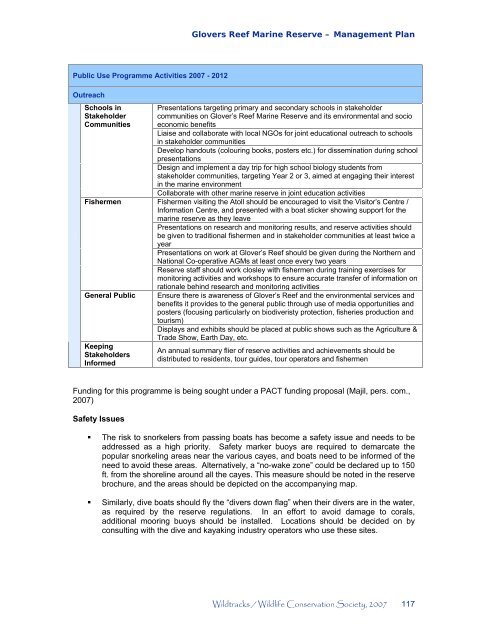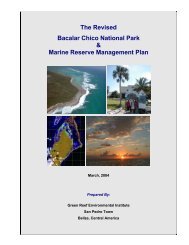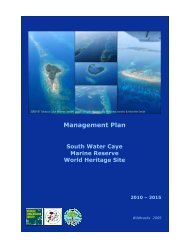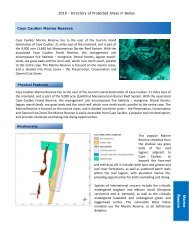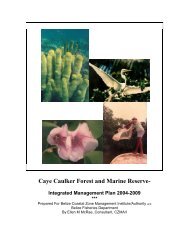Management Plan - Glover's Reef Marine Reserve
Management Plan - Glover's Reef Marine Reserve
Management Plan - Glover's Reef Marine Reserve
You also want an ePaper? Increase the reach of your titles
YUMPU automatically turns print PDFs into web optimized ePapers that Google loves.
Public Use Programme Activities 2007 - 2012<br />
Outreach<br />
Schools in<br />
Stakeholder<br />
Communities<br />
Fishermen<br />
General Public<br />
Keeping<br />
Stakeholders<br />
Informed<br />
Glovers <strong>Reef</strong> <strong>Marine</strong> <strong>Reserve</strong> – <strong>Management</strong> <strong>Plan</strong><br />
Funding for this programme is being sought under a PACT funding proposal (Majil, pers. com.,<br />
2007)<br />
Safety Issues<br />
Presentations targeting primary and secondary schools in stakeholder<br />
communities on Glover’s <strong>Reef</strong> <strong>Marine</strong> <strong>Reserve</strong> and its environmental and socio<br />
economic benefits<br />
Liaise and collaborate with local NGOs for joint educational outreach to schools<br />
in stakeholder communities<br />
Develop handouts (colouring books, posters etc.) for dissemination during school<br />
presentations<br />
Design and implement a day trip for high school biology students from<br />
stakeholder communities, targeting Year 2 or 3, aimed at engaging their interest<br />
in the marine environment<br />
Collaborate with other marine reserve in joint education activities<br />
Fishermen visiting the Atoll should be encouraged to visit the Visitor’s Centre /<br />
Information Centre, and presented with a boat sticker showing support for the<br />
marine reserve as they leave<br />
Presentations on research and monitoring results, and reserve activities should<br />
be given to traditional fishermen and in stakeholder communities at least twice a<br />
year<br />
Presentations on work at Glover’s <strong>Reef</strong> should be given during the Northern and<br />
National Co-operative AGMs at least once every two years<br />
<strong>Reserve</strong> staff should work closley with fishermen during training exercises for<br />
monitoring activities and workshops to ensure accurate transfer of information on<br />
rationale behind research and monitoring activities<br />
Ensure there is awareness of Glover’s <strong>Reef</strong> and the environmental services and<br />
benefits it provides to the general public through use of media opportunities and<br />
posters (focusing particularly on biodiveristy protection, fisheries production and<br />
tourism)<br />
Displays and exhibits should be placed at public shows such as the Agriculture &<br />
Trade Show, Earth Day, etc.<br />
An annual summary flier of reserve activities and achievements should be<br />
distributed to residents, tour guides, tour operators and fishermen<br />
The risk to snorkelers from passing boats has become a safety issue and needs to be<br />
addressed as a high priority. Safety marker buoys are required to demarcate the<br />
popular snorkeling areas near the various cayes, and boats need to be informed of the<br />
need to avoid these areas. Alternatively, a “no-wake zone” could be declared up to 150<br />
ft. from the shoreline around all the cayes. This measure should be noted in the reserve<br />
brochure, and the areas should be depicted on the accompanying map.<br />
Similarly, dive boats should fly the “divers down flag” when their divers are in the water,<br />
as required by the reserve regulations. In an effort to avoid damage to corals,<br />
additional mooring buoys should be installed. Locations should be decided on by<br />
consulting with the dive and kayaking industry operators who use these sites.<br />
Wildtracks / Wildlife Conservation Society, 2007 117


